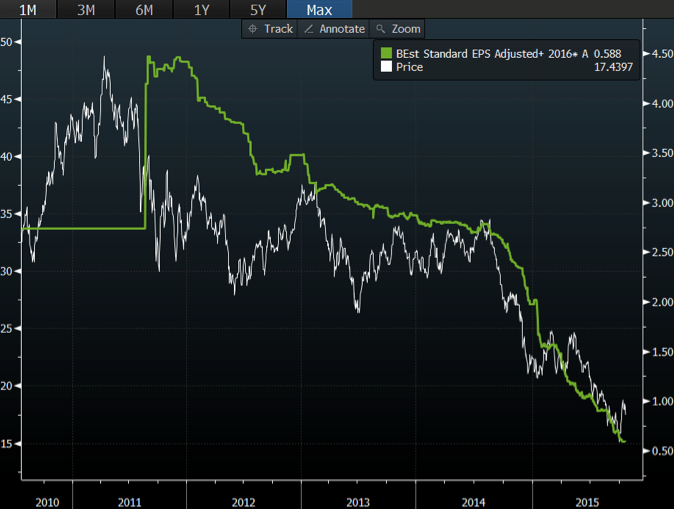
Know Your Limits
Here’s a striking chart. It tracks the share price of BHP Billiton (ASX: BHP) over the past five years, together with the average analyst forecast for BHP’s FY16 Earnings Per Share (EPS) during that period. Unsurprisingly, the two have moved together. Also, changes to analyst forecasts have tended to follow changes to the share price. You might think it should be the other way around, but that’s a discussion for another time.
 The point that I think is worth making here is the importance of investing within your sphere of competence. If you are investing with a view to achieving a better-than-average return, you should have some insight into the businesses you invest in. More specifically, when you buy part of a business from someone, it helps if you know more about its value, quality and prospects than the person selling it to you.
The point that I think is worth making here is the importance of investing within your sphere of competence. If you are investing with a view to achieving a better-than-average return, you should have some insight into the businesses you invest in. More specifically, when you buy part of a business from someone, it helps if you know more about its value, quality and prospects than the person selling it to you.
At Montgomery Investment Management, we have a substantial research team, and a reasonably wide sphere of competence. However, when it comes to resources companies, we frequently draw a blank. The problem is that the value of a resources business depends critically on the price of the stuff it sells, and when we try to forecast commodity prices we usually have to admit that we just can’t do it with enough confidence. Without knowing commodity prices, we can’t have confidence in our value estimates, and a high conviction manager needs a certain amount of…conviction.
We’re not alone here. The chart above, which appears to show BHP analysts revising down their forecasts every ten minutes or so to get from a $4.00+ EPS estimate to one closer to $0.50, illustrates the point. BHP is probably among the highest quality resources companies in the world, but clearly it is fiendishly difficult to forecast years in advance what its earnings will be. This is not a criticism of the broking analysts. I doubt I could do any better in their shoes.
As an aside, this unpredictability of earnings can make for some very legitimate short-selling opportunities, particularly among the lower quality names. Companies that take on excessive debt in the good times to subsequently find their cash flows disappear can end up having what’s called an “asymmetric payoff” – ie. lots of downside potential and not so much upside.
For long-only investors though, if you are tracking an index then clearly BHP will be in your portfolio, and no one can argue with that. However, if you are trying to achieve superior returns by owning undervalued companies, then you need to be able to estimate the value of the companies you hold.
When it comes to resources companies, that’s a tall order.
Tim Kelley is Montgomery’s Head of Research and the Portfolio Manager of The Montgomery Fund. To invest with Montgomery domestically and globally, find out more.
Hi Tim (This is my first ever message to Montgomery)
I hold BHP. I bought them at around $11. I recently heard a comment that BHP could end up at $9 if things keep going as is. What are you thoughts and recommendations.
Also, can I ask what do you think of MPL. I bought in with ISO (float)
Thanks
Hi Maureen. As per the article above, we don’t have any particular insight into BHP, and so can’t provide much help on this. We think MPL is a good quality business with long term potential. Be sure to seek and take personal professional advice.